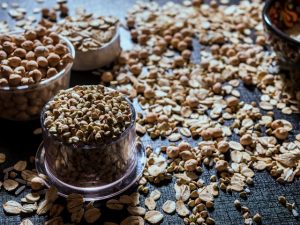
- The components of a healthy plate include vegetables, fruits, lean proteins, and whole grains.
- Portion control and balance are crucial for maintaining a balanced diet, preventing overeating, and managing weight.
- To build a nutrient-dense plate, prioritize variety, incorporate colorful fruits and vegetables, and follow healthy eating guidelines for balanced meals.
In the pursuit of well-being, understanding the composition of a healthy plate is paramount. This article delves into this fundamental aspect of nutrition, illuminating the significance of balanced eating for holistic health. With a plethora of dietary advice circulating, deciphering what constitutes a genuinely nourishing plate can be daunting. However, grasping this concept empowers individuals to make informed food choices and lays the foundation for a resilient and thriving lifestyle.
The impact of diet on health and disease prevention cannot be overstated. Every morsel consumed plays a role in shaping physiological and psychological well-being. From preventing chronic diseases like heart disease, diabetes, and certain cancers to maintaining a healthy weight and optimal energy levels, the influence of dietary habits reverberates throughout our lives. Understanding the intricate relationship between nutrition and health enables individuals to harness the transformative power of food, fostering longevity and vitality. Thus, exploring what a healthy plate looks like becomes a matter of sustenance and a cornerstone of proactive health management.
The Components of a Healthy Plate
A truly nourishing plate is a symphony of diverse elements, each crucial in promoting overall well-being. From vibrant vegetables to succulent fruits, protein-rich sources, and hearty whole grains, the components of a healthy plate offer a spectrum of nutrients essential for optimal health. Explore these components below, unraveling their unique contributions to a balanced diet and a thriving body.
Vegetables
Vegetables form the vibrant basics of a healthy plate, offering many essential nutrients vital for overall well-being. Their vivid hues signify the presence of various vitamins, minerals, and antioxidants, each playing a pivotal role in supporting bodily functions and combating disease. From the deep greens of spinach to the bright orange of carrots, the diversity of colors in vegetables reflects their rich nutritional profiles. Understanding vegetable nutrition and appropriate serving sizes is key to maximizing their health benefits. According to dietary guidelines, a standard serving of vegetables typically equates to about 75g, providing anywhere from 100 to 350 kilojoules of energy.
To attain optimal health, it’s recommended to incorporate a variety of vegetables into daily meals, ensuring a diverse intake of nutrients. This diversity not only enhances the nutritional quality of one’s diet but also promotes gut health and supports a robust immune system. Recommended vegetable serving sizes may look like half a cup of cooked green or orange vegetables like broccoli or carrots, a cup of raw salad vegetables, or half a medium potato. Additionally, choices such as sweet corn, leafy greens, and legumes like beans or lentils offer further avenues to enrich one’s diet with essential vitamins, minerals, and fiber.
Embracing the rainbow of vegetables on your plate enhances its visual appeal and fosters holistic health. By incorporating recommended servings of colorful vegetables into meals, individuals can fortify their bodies against disease and thrive with vitality. Whether it’s the crisp crunch of a raw salad or the comforting warmth of roasted root vegetables, each vegetable is a nutrient powerhouse, contributing to a balanced and nourishing diet essential for optimal well-being.
Fruits
Incorporating fruits into daily meals is crucial for maintaining a balanced and nutritious diet. Fruits are packed with essential vitamins, minerals, antioxidants, and dietary fiber, all contributing to overall health and well-being. Regular consumption of fruits has been linked to a reduced risk of chronic diseases such as heart disease, stroke, and certain types of cancer. Additionally, fruits are naturally low in calories and fat, making them an excellent choice for those looking to manage their weight effectively.
According to dietary guidelines, aiming for 4-5 servings of fruits per day is recommended. Fruit serving sizes typically constitute one medium-sized fruit, half a cup of fresh, frozen, or canned fruit, a quarter cup of dried fruit, or a quarter cup of fruit juice. By understanding fruit nutrition, individuals can ensure they meet their nutritional needs while enjoying a variety of flavors and textures.
When selecting and preparing fruits, opting for a diverse range to reap the maximum nutritional benefits is essential. Look for fresh, ripe, and in-season fruits to ensure optimal flavor and nutrient content. Experiment with different types of fruits, including berries, citrus, tropical, and stone fruits, to add variety to your diet. Consider incorporating fruits into meals, snacks, or desserts when preparing them. Try adding sliced fruits to yogurt or oatmeal for breakfast, blending them into smoothies for a refreshing beverage, or incorporating them into salads for flavor and color.
Additionally, consider freezing fruits on hand for convenient snacking or use in recipes throughout the year. By incorporating a variety of fruits into your diet and experimenting with different preparation methods, you can enjoy the numerous health benefits while adding vibrancy and flavor to your meals.
Protein
Protein sources play a pivotal role in maintaining muscle health and promoting satiety within our diets. Lean protein options, in particular, are essential for these purposes. Lean protein not only aids in building and repairing muscle tissues but also helps keep us full for longer periods, making it an integral component of a balanced diet. Incorporating lean protein into meals can contribute significantly to overall health and well-being.
A variety of protein-rich foods can serve as excellent sources of lean protein. Poultry, such as chicken or turkey, is a staple choice, providing lean protein and essential nutrients. Fish, particularly those like salmon or tuna, offer lean protein and heart-healthy omega-3 fatty acids. For individuals following a plant-based diet, beans and tofu are excellent options, offering protein while also being rich in fiber and other nutrients. These foods provide versatility in meal preparation while ensuring adequate protein intake.
Understanding serving sizes is crucial when incorporating various lean protein options into meals. A standard serving size typically consists of 3 ounces of cooked lean meat, poultry, or fish, providing a balanced amount of protein while keeping portions in check. Additionally, two egg whites or one whole egg, ¼ cup of cooked beans, one tablespoon of peanut butter, or half an ounce of unsalted nuts or seeds are all examples of appropriate serving sizes for various protein-rich foods. Being mindful of serving sizes ensures one obtains nutrients from these protein sources without overindulging. By incorporating these guidelines into daily dietary habits, individuals can optimize their lean protein intake for improved muscle health and satiety.
Whole Grains
Whole grains also play a crucial role in providing essential nutrients such as fiber, vitamins, and minerals. Whole grain nutrition encompasses the entirety of the grain kernel, including the bran, germ, and endosperm, retaining valuable nutrients often lost during processing. Fiber, an integral component of whole grains, aids digestion, promotes satiety, and helps maintain healthy cholesterol levels. Additionally, whole grains are rich in B vitamins (including thiamin, riboflavin, and niacin) and minerals like iron, magnesium, and selenium, essential for various bodily functions, including energy production, immune health, and bone strength. By incorporating whole grains into one’s diet, individuals can attain diverse nutrients vital for optimal health and longevity.
Examples of healthy grains include brown rice, quinoa, and whole wheat bread, all offering substantial nutritional benefits. Brown rice, a staple in many cuisines, is a whole grain packed with fiber, B vitamins, and minerals such as magnesium and selenium. Quinoa, a pseudo-cereal, stands out for its exceptional protein content and is a complete protein source, containing all nine essential amino acids. Furthermore, quinoa is rich in fiber, iron, and magnesium, making it a nutritious addition to any meal.
Whole wheat bread, made from whole wheat flour, retains the nutrient-rich bran and germ, providing a good source of fiber, B vitamins, and minerals like iron and zinc. Incorporating these whole grain options into one’s daily diet helps meet the recommendations for healthy grain consumption and contributes to overall health and well-being.
Portion Control and Balance
Portion control is essential in maintaining a balanced diet, ensuring individuals consume appropriate food groups to meet their nutritional needs without overindulging. By practicing portion control, individuals can avoid excessive calorie intake while enjoying various foods. This approach promotes weight management, helps regulate blood sugar levels, and reduces the risk of chronic diseases such as obesity, diabetes, and heart disease. Incorporating portion control tips into meal planning can empower individuals to make mindful choices and cultivate a healthy relationship with food.
Strategically portioning different food groups on a plate is vital to achieving dietary balance and meeting nutritional goals. A practical approach involves dividing the plate into sections dedicated to protein, carbohydrates, and vegetables. Aim to fill half the plate with non-starchy vegetables, such as leafy greens, broccoli, and peppers, to increase fiber intake and promote satiety. Reserve a quarter of the plate for lean protein sources like poultry, fish, tofu, or legumes, which provide essential amino acids for muscle repair and growth. Finally, allocate the remaining quarter for carbohydrates, opting for whole grains like brown rice, quinoa, or whole wheat bread to sustain energy levels and support digestive health. By portioning different food groups in this manner, individuals can create balanced meals that supply a variety of nutrients while controlling calorie intake.
Balanced meal planning extends beyond portion control to include the careful consideration of macronutrients to meet dietary goals. Strive to incorporate a mix of carbohydrates, proteins, and fats into each meal to support overall health and well-being. For example, pairing complex carbohydrates with lean proteins and healthy fats can help stabilize blood sugar levels, promote muscle repair, and enhance satiety. Experiment with different food combinations and recipes to create satisfying meals that align with dietary preferences and nutritional requirements. Additionally, pay attention to portion sizes and serving recommendations to ensure each meal provides a balanced array of macronutrients. Individuals can cultivate healthy eating habits that contribute to long-term wellness and vitality by prioritizing portion control and balanced meals.
Building a Nutrient-Dense Plate
Crafting a nutrient-dense plate involves adhering to healthy eating guidelines while prioritizing incorporating a variety of nutrients from different food groups. Models like MyPlate offer practical guidelines for constructing balanced meals, which include fruits, vegetables, grains, protein, and dairy in appropriate proportions. By following such models, individuals can ensure their plates are rich in essential vitamins, minerals, fiber, and other micronutrients necessary for optimal health. Incorporating nutrient-dense foods into meals promotes overall well-being and helps individuals meet their daily nutritional requirements.
To enhance the nutritional diversity of a meal, it’s essential to incorporate various colors, textures, and flavors into the plate. Each color in fruits and vegetables signifies the presence of specific phytochemicals and antioxidants, which offer unique health benefits. By including a rainbow of produce, such as leafy greens, vibrant berries, and cruciferous vegetables, individuals can maximize the nutritional value of their meals and support various aspects of health, including immune function, heart health, and digestion. Similarly, integrating a variety of textures, from crunchy to creamy, and flavors, from sweet to savory, adds depth and interest to meals while providing a range of nutrients. By embracing diversity in food choices, individuals can create nutrient-dense meals that nourish the body and delight the palate.
Healthy Eating FAQs (Frequently Asked Questions)
How can I make my meals more balanced and nutritious?
Aim for variety by incorporating fruits, vegetables, lean proteins, and whole grains to make meals more balanced and nutritious. Follow portion control guidelines and prioritize nutrient-dense foods to meet dietary needs effectively.
What are some healthy options for each food group?
Healthy options for each food group include:
Fruits: Berries, apples, oranges
Vegetables: Spinach, broccoli, bell peppers
Protein: Chicken breast, salmon, lentils
Whole Grains: Quinoa, brown rice, whole wheat bread
How can I control portion sizes without feeling deprived?
Control portion sizes by using smaller plates, measuring servings, and filling half your plate with veggies. Eat slowly, savoring each bite, and stop when satisfied, not overly full.
Are there specific dietary recommendations for different age groups?
Dietary recommendations vary by age group. Generally, aim for a balanced diet rich in fruits, vegetables, lean proteins, and whole grains, adjusting portions based on individual needs and activity levels.
Can I still enjoy my favorite foods while following a healthy plate model?
With some nutrition tips, you can enjoy your favorite foods in moderation. Incorporate them into a balanced plate alongside nutritious options, prioritizing portion control and variety for overall health.
People Also Ask
What is an example of a healthy plate?
A healthy plate example includes colorful veggies like spinach, lean proteins such as grilled chicken, whole grains like quinoa, and a serving of fruit for dessert. Balancing these components ensures a well-rounded, nutritious meal.
What are some ideas for a balanced meal?
Balanced meal ideas include a salad with mixed greens, grilled salmon, quinoa, and roasted vegetables. Another option is a stir-fry with tofu, brown rice, and various colorful veggies.
Does the color of fruits and vegetables mean anything?
The color of fruits and vegetables signifies different nutrients. For instance, orange fruits and veggies like carrots contain beta-carotene, while dark leafy greens are rich in iron and calcium.
Conclusion
Understanding what a healthy plate looks like is paramount for overall well-being. It is the foundation for making informed dietary choices, ensuring that individuals meet their nutritional needs while promoting optimal health. Individuals can create balanced meals that nourish the body and support vitality by incorporating various nutrient-rich foods such as vegetables, fruits, lean proteins, and whole grains.
As we strive to cultivate healthier eating habits, let’s remember the importance of incorporating balanced meals into our daily routines. By prioritizing portion control, variety, and nutrient density, we empower ourselves to make choices that contribute to long-term wellness. Embrace the journey of exploring new flavors, textures, and culinary traditions while prioritizing the nourishment of the body and mind. Always remember that consulting a healthcare provider or registered dietitian is invaluable for personalized nutrition advice tailored to individual needs and health goals. With dedication and mindful eating, we can embark on a path towards a healthier, happier life.
Francis Pitt
Latest posts by Francis Pitt (see all)
- Custom Menus and Dietary Options Offered by Catering Services - June 25, 2025
- How to Open the Best Affordable Loose Leaf Tea Cafe - February 20, 2025
- What to Know About Livestock Residue Studies - January 2, 2025





